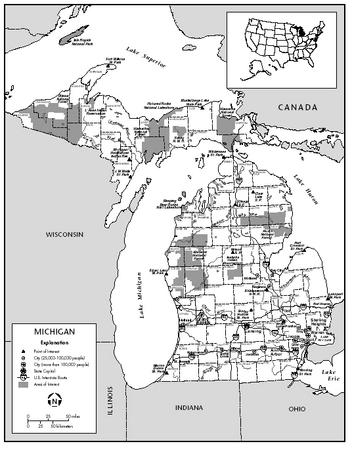Michigan
Environmental protection
The Michigan Department of Natural Resources (DNR) is the state's 4th-largest department employing approximately 3,700 persons. It is responsible for the administration of hundreds of programs affecting every aspect of the environment. These programs are based on state and federal laws calling for the protection and management of natural resources, including: air, water, fish, wildlife, recreational activities, wetlands, forests, minerals, oil, and gas. The regulatory programs operated by the DNR conserve and manage natural resources by controlling access or limiting their use and removal. Most of these programs rely on permit or license systems such as hunting or fishing licenses, forest use permits, and air/wastewater discharge permits.
Responding to citizens' concerns and new federal legislation, Michigan enacted programs to address water and air pollution as well as waste problems. At least 10 major environmental programs were established under Michigan law during the 1970s and 1980s, directing the DNR to assume new responsibilities and authorities. These included the Wetland Protection Act of 1980, Inland Lakes and Streams Act, the Resource Recovery Act, the Solid Waste Management Act, and the Hazardous Waste Management Act. In addition, changes in administrative rules and amendments to existing statutes greatly expanded the scope of some programs such as air and water pollution control (Air Pollution Control Act and Water Resources Commission Act).

Governor William Milliken decided Michigan would be better served if all environmental programs were under one roof. Executive Order 1973-2 transferred three programs from the Department of Public Health to the DNR, including sewage system maintenance and certification; solid waste disposal; and licensing of septic tank cleaners. Further transfers were accomplished under Executive Order 1973-2a, which changed the status of the Water Resources Commission (WRC), making it subordinate to the Natural Resources Commission (NRC). Additionally, Executive Order 1973-2a transferred the Air Pollution Control Commission to the DNR under the jurisdiction of the NRC. The Executive Order divided the DNR for the first time into two branches: the natural resources branch, and the environmental protection branch. The Executive Orders of 1973 clearly consolidated and defined the DNR's environmental protection responsibilities.
As the 1970s drew to a close, Michigan enacted two major pollution control laws: the Solid Waste Management Act and the Hazardous Waste Management Act. These acts provide the legal basis for the separate management of hazardous wastes under a detailed regulatory program. The two waste management laws substantially increased the DNR's enforcement and administrative responsibilities. In addition to these two acts, several other laws were enacted or amended by the legislature in the late 1970s and 1980s which had a major impact on the Department. For example, the Environmental Response Act provides for the identification of sites of environmental contamination throughout the state and an appropriation procedure to support the cleanup of contamination sites in the state. Other programs created by statute included the Clean Michigan Fund and the Leaking Underground Storage Tanks Act. Each of these statutes required the DNR to assume new program responsibilities and authorities in the 1980s.
As the policy body over the DNR, the NRC consists of seven members appointed by the governor, with the advice of the senate. The NRC sets the overall direction of the department and hires the director to carry out its policies. The department is organized both programmatically and geographically. The three program areas, each headed by a deputy director, include: resource management; environmental protection; and policy, budget, and administration. The three geographical regions split the state into the north, central, and south zones, each headed by a deputy director. The deputy directors report to the director of the DNR.
The mission of the department is to conserve and develop the state's natural resources and to protect and enhance the state's environmental quality in order to provide clean air, clean water, productive land, and healthy life. Additionally, the department seeks to provide quality recreational opportunities to the people of Michigan through the effective management of state recreational lands and parks, boating facilities, and population of fish and wildlife.
In 2003, Michigan had 343 hazardous waste sites listed in the Environmental Protection Agency's database, 66 of which were on the National Priorities List. In 2001, Michigan received $138,075,000 in federal grants from the Environmental Protection Agency; EPA expenditures for procurement contracts in Michigan that year amounted to $26,847,000.